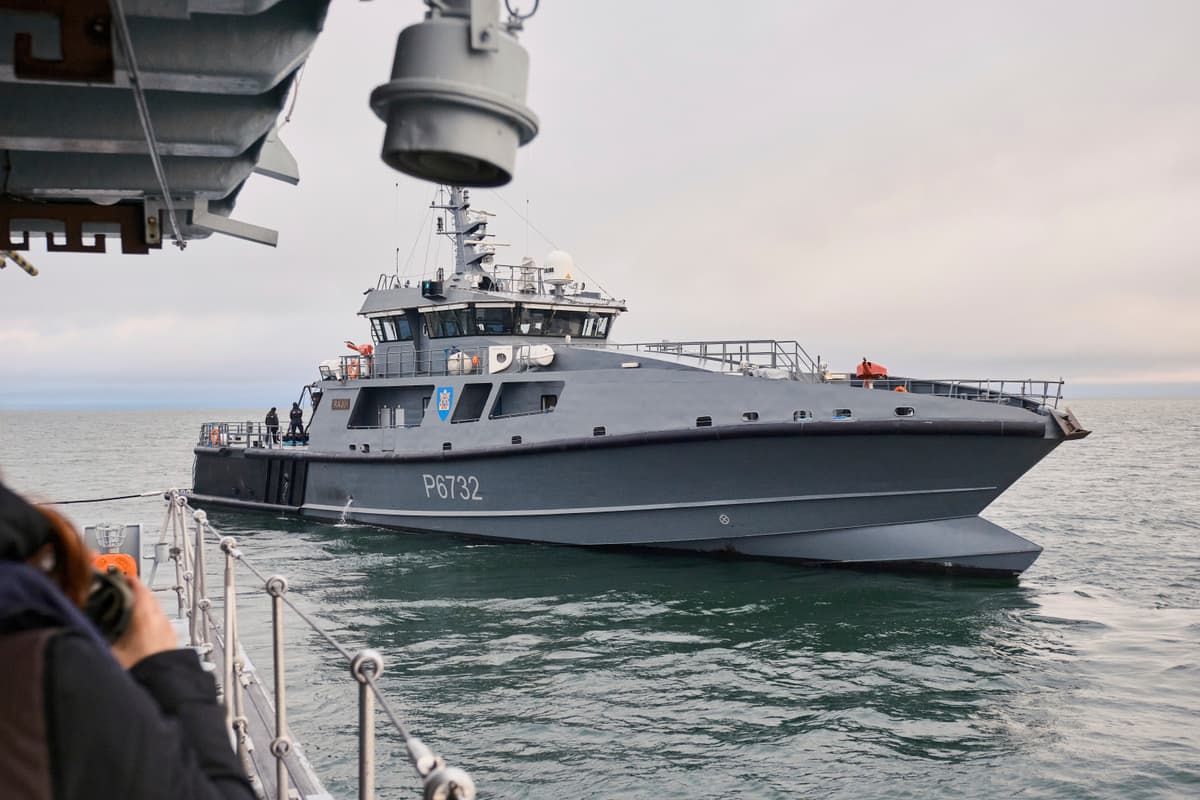Baltic Sea, as China and Russia Start Cutting Undersea Cables, Is Emerging as a ‘Theater of Military Operations’
Chinese researchers apply for patents for ‘submarine cable cutting devices,’ while Russian experts boast on television that cable-cutting will ‘freeze’ Finland.

Chinese researchers apply for patents for “submarine cable cutting devices.” Russian security experts boast on state TV that cable cutting in the Baltic Sea will “freeze” Finland this winter.
Northern Europe, where 10 North Atlantic Treaty warships are converging on the Baltic patrol duty, is quickly moving past the fiction that the cutting of underwater internet, telephone and electricity cables is “accidental.”
Just one year ago, Scandinavian and Baltic nations believed they lived on a peaceful “NATO lake.” Now, however, public statements and filings in Russia and Communist China are pointing directly to Moscow’s and Beijing’s hybrid war against the Baltic.
So far, the sabotaged cables have been backed up with redundancies. The closest call was the Christmas Day cutting of Estlink 2, a power cable between Finland and Estonia.
Despite the severing of the cable, Estonia is expected to be able meet its electricity needs until cable repairs are completed next summer.
The focus on Baltic undersea cables comes as next month, the power grid operators of Estonia, Latvia, and Lithuania are set to decouple from the Soviet-era joint BRELL power grid with Russia and Belarus. These electric power ties are a legacy of the Soviet occupation of the Baltics 80 years ago.
Sensing that the “coincidences” are really a campaign, leaders of eight nations of the North Atlantic Treaty gathered at Helsinki yesterday to launch “Baltic Sentry” — a long-term maritime patrol, involving aircraft, drones, and 10 frigates.
The North Atlantic Treaty Organization’s secretary general, Mark Rutte, told reporters: “Potential threats to our infrastructure will have consequences, including possible boarding, impounding and arrest.”
Analysts fear scattered attacks are dress rehearsals for wider warfare, one with crippling consequences. After Russia launched its attack on Ukraine in 2022, Norway displaced Russia to become the biggest natural gas supplier to the European Union. While Norway now supplies half of Europe’s pipeline gas, Russia’s gas export monopoly, Gazprom, weighs cutting 40 percent of its headquarter jobs — 1,500 posts.
Cables, though, may become Norway’s Achilles heel. To cut carbon dioxide emissions, Norway is phasing out gas turbines to power its offshore oil and gas platforms. Replacing autonomous, platform-based, gas systems, the platforms will depend on electricity from land-based charging stations, linked by power lines along the seabed.
“That means most of Norway’s energy production depends on the impeccable functioning of electricity cables,” Elisabeth Braw writes in a Foreign Policy essay: “Russia’s Cable-Cutting Could Threaten Europe’s Whole Energy Supply.” “With just a few sliced cables, Russia — perhaps with China’s help again — could disrupt a continent.”
China’s fingerprints are coming into focus. On Friday, Newsweek reported that in 2020 a team of engineers at Lishui University, in a coastal province opposite Taiwan, applied for a “dragging type submarine cable cutting device.” The six authors wrote: “There is a need for a fast, low cost cutting apparatus for submarine cables to accomplish this task.”
Building on earlier work in 2009 by marine engineers at the State Oceanic Administration of China, the Lishui team said the cutting anchor could be hauled up to check for copper residue, an indication of a successful cut. Copper is the preferred conductor material used in subsea cables.
Moving to practice from theory, on January 3, a Communist Chinese cargo ship, the Xing Shun 39, most likely cut a telecommunications cable off the north coast of Taiwan, says the Coast Guard of the Nationalist Chinese government. In 2023, a Communist Chinese fishing vessel reportedly cut submarine communications cables to Matsu, a Nationalist island five miles off the coast of Communist China.
In the Baltic, Chinese activity has accelerated. Last summer, Beijing admitted that one of its ships, the Newnew Polar Bear, dragged an anchor damaging one gas pipeline and two undersea cables in the Gulf of Finland in October 2023. In that case, the ship quickly left the Baltic, sailed around Norway, and entered the safety of Russia’s Arctic.
NATO nations now move faster. In November, a Chinese-flagged bulk carrier, the Yi Peng 3, was suspected of dragging its anchor to cut two fiber optic Internet cables in Swedish economic waters. Danish Navy boats intercepted the ship as it attempted to leave the Baltic.
The ship was impounded for a month until Beijing allowed Swedish police to board and interrogate the crew. On Sunday, Sweden’s Civil Defence Minister Carl-Oskar Bohlin said authorities determined the Chinese ship had attempted to cut a third cable, a power cable connecting Sweden and Lithuania. The Chinese ship’s last port of call was Ust-Luga, Russia.
Another suspected sabotage ship that lists Russia as its last port of call is the Eagle S. Loaded with 739,000 barrels of Russian oil, this Aframax class tanker is part of a “shadow” fleet of about 600 tankers that ignore Western sanctions and move Russian oil to clients, largely in India and Communist China. Finnish authorities believe the Eagle S dragged its portside anchor for 60 miles along the Baltic seabed, cutting Finland-Estonia Estlink 2 power line and four telecoms cables.
Moving fast, Finland landed commandos on the ship’s decks and impounded the vessel and its $60 million cargo. Nine of the largely Georgian crew of 24 are forbidden to travel. The head of Finland’s investigation, Risto Lohi, told Reuters Monday that, when it was seized, the vessel was moving to cut a second power cable, Estlink1, and the BalticConnector gas pipe between Finland and Estonia. Seeking compensation, Finnish telecom company Cinia stated: “Cinia demands the seizure of the vessel Eagle S, which has been linked to cable damages in the Gulf of Finland.”
Reflecting growing jitters around the Baltic, Poland’s TVP World reported yesterday that a Russian ‘shadow ship’ had been observed circling around the pipeline that brings gas from Norway to Poland. Poland’s army said the report was false. One concrete concern is the fully loaded, Panamanian-flagged “shadow” tanker Jazz. Suffering from engine trouble, it has broken down twice in two weeks in the Baltic. German tugboats succeeded in controlling the drifting vessel and brought it to an anchorage in Danish waters.
Officially, Russia denies any responsibility for the shadow fleet or for the cable sabotage. After Denmark detained the Yi Peng 3, Kremlin spokesman Dmitry Peskov told reporters: “It is quite absurd to continue to blame Russia for everything without any reason.” Unofficially, some Russians are gleeful.
On Sunday, a former deputy foreign minister, Andrei Federov, told “Meeting Place” NTV talk show that the “deliberate destruction of a cable” was “a beautiful story: we were sailing and we accidentally dropped our anchor and accidentally hit a cable.” When host Ivan Trushkin asked him why do it?, Mr. Federov responded: “To create problems for them — and it is creating problems.”
Another guest, a Russian Duma member, Alexander Kazakov, said the cable cutting campaign is in response to “Ukraine’s aggressive actions.” “Our goal is to liberate the Baltic Sea for ourselves, this is a theater of military operations,” he said. “Our people said: ‘let’s inflict damage upon NATO.’ For example, let’s cut the cables. Here you go, we are cutting them.”
Naval police patrolling the Baltic beat this year may reduce this increasingly dangerous vandalism. At yesterday’s regional meeting Latvia’s president, Edgars Rinkevics, told reporters: “Let’s face it, we can’t ensure 100% protection. But if we are sending a bold signal, then I think that such incidents are going to decrease or even stop.”

